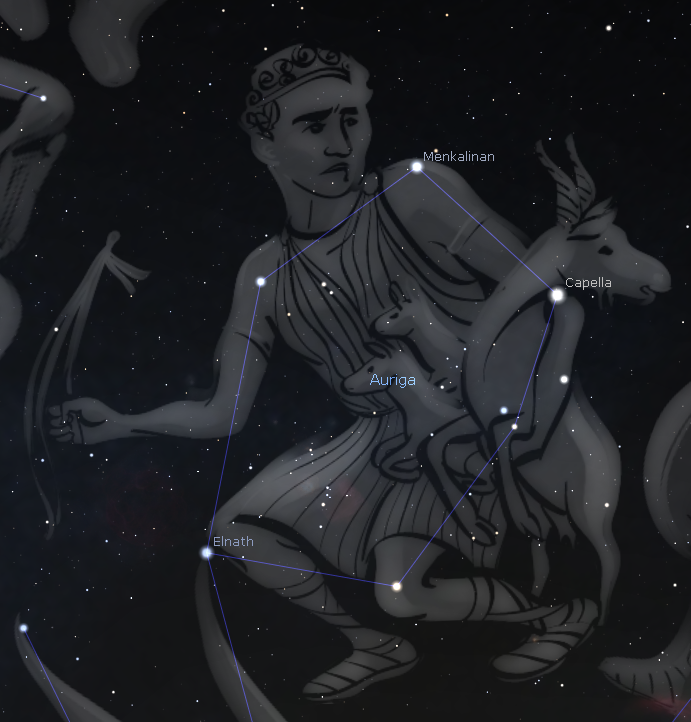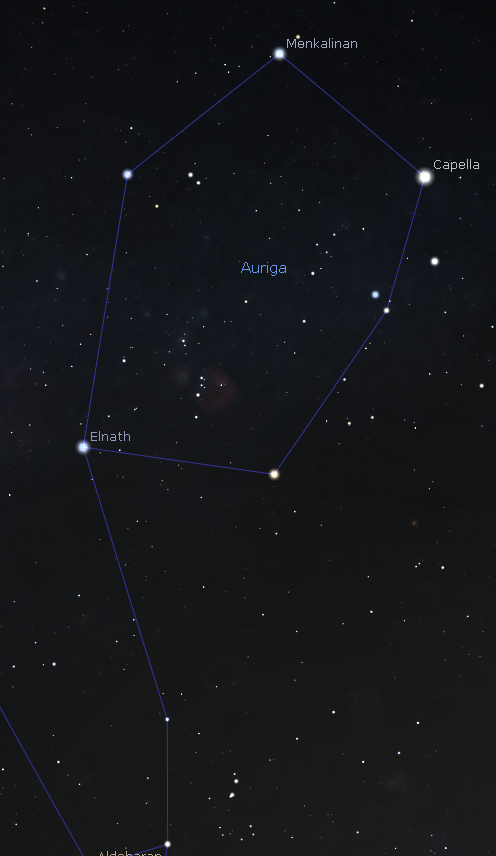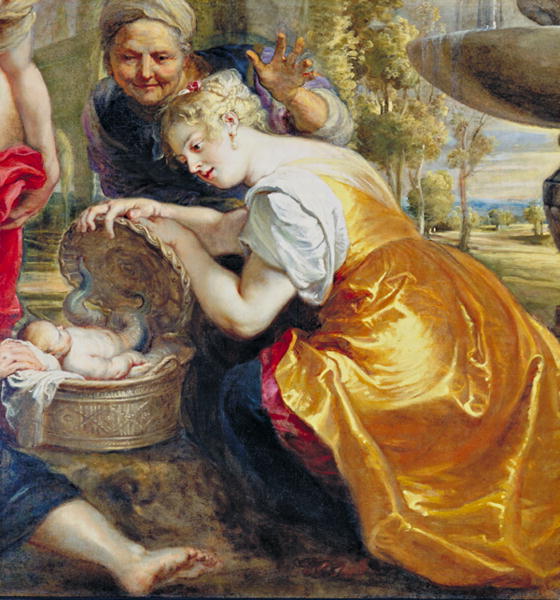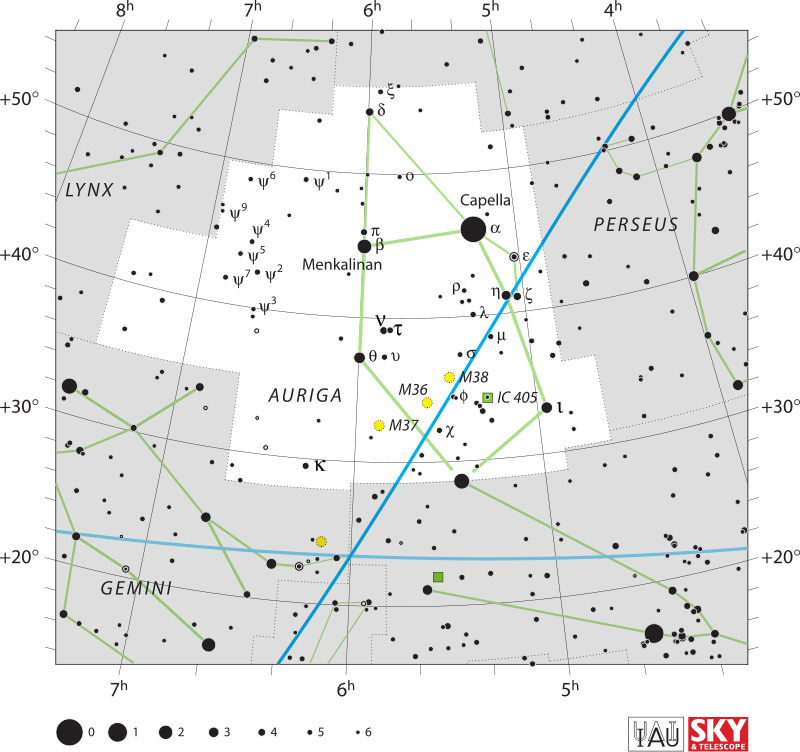|
Auriga, Latin for ‘(the) Charioteer’ is north of the celestial equator and one of the forty-eight constellations listed by astronomer Claudius Ptolemy. The constellation is prominent through the winter months in the Northern Hemisphere along with five other constellations which form the Winter Hexagon or Winter circle asterism.
The constellation is only viewable in full as far south as -34 degrees and is ranked 21st in size out of the eighty-eight total constellations. Auriga has remained a constellation since Ptolemy's day and is legally acknowledged by the International Astronomical Union, however it is currently defined as a specific region of the sky that includes both the ancient pattern and the surrounding stars, as are all modern constellations. (Bakich 1995) |
|
Greek Mythology
Auriga is often identified as the mythological Greek hero Erichthonius of Athens, the son of Hephaestus who is often chaotic and was raised by the goddess Athena. Erichthonius was repeatedly recognised for the invention of the quadriga – the four-horse chariot, which was used in the battle against the usurper Amphictyon, which was known as the event that make Erichthonius the king of Athens (Moore & Tirion 1997). After the Athenian hero dedicated himself to Athena which soon after Zeus honoured him by raising him into the night sky for his heroic deeds. Auriga, on the other hand, is sometimes referred to as Myrtilus, Hermes' son and Oenomaus' charioteer. [11] The constellation Auriga is often depicted with a chariot, which supports the link between Auriga and Myrtilus. In a race for suitors to capture the heart of Oenomaus' daughter Hippodamia, Myrtilus' chariot was destroyed. Despite his cooperation in aiding Pelops to win Hippodamia's hand, Myrtilus earned his place in the heavens when Pelops, Hippodamia's victorious suitor, killed him. Myrtilus' father, Hermes, placed him in the sky after he died. Hippolytus, the son of Theseus, is another legendary association of Auriga. He was expelled from Athens after refusing his stepmother Phaedra's love advances, which led to her suicide. When his chariot was destroyed, he was killed but was later revived by Asclepius. (Staal 1988) Auriga is also thought to depict Phaethon, the sun Helios' son, who duped his father into letting him drive his chariot for a day. Phaethon collided with the earth and exploded, burning it. He was then renamed Auriga and put in the night sky. [15] Regardless of Auriga's particular representation, the ancient Greeks most likely constructed the constellation to honour the chariot's prominence in their civilization. (Winterburn 2009) Capella is linked to Amalthea, the fabled she-goat who breastfed Zeus as a child. The stars Epsilon Aurigae, Zeta Aurigae, and Eta Aurigae, the last two of which are known as the Haedi, form an asterism (the Kids). (Ridpath & Tirion 2001) Capella is most typically associated with Amalthea, but she has also been linked to Amalthea's owner, a nymph. According to the nymph tale, the goat's horrible look, which resembled that of a Gorgon, contributed to the Titans' downfall since Zeus skinned the goat and wore it as his aegis. The asterism comprising the goat and kids had previously been a unique constellation; however, Claudius Ptolemy united the Charioteer and the Goats. Before that, Pliny the Elder and Manilius saw Capella as a separate constellation called Capra, Caper, or Hircus, all of which refer to its status as the "goat star." Cleostratus, an ancient Greek astronomer, first called Zeta Aurigae and Eta Aurigae the "Kids." Auriga has traditionally been shown as a chariot and its driver in the artwork. The charioteer carries two kids under his left arm and a goat over his left shoulder; he holds the chariot reins in his right hand. Auriga has, nevertheless, been depicted in a variety of ways over the years. Though Capella is generally always over his left shoulder and the Kids under his left arm, the reins in his right hand have been portrayed like a whip. The four-wheeled cart driven by Auriga, who holds the reins of two oxen, a horse, and a zebra, was depicted in the 1488 atlas Hyginus, which deviates from the traditional representation. (Pasachoff 2006) In his Hyginus of 1535, Jacob Micyllus represented Auriga as a charioteer with a two-wheeled cart drawn by two horses and two oxen. Arabic and Turkish images of Auriga differed from those of the European Renaissance; one Turkish atlas represented Auriga's stars as a mule, which Johann Bayer named Mulus clitellatus. Auriga as Adam kneeling on the Milky Way, with a goat wrapped over his shoulders, was shown in a 17th-century French painting. (Olcott 2004)(Allen 1899) Non-western astronomy Auriga's stars have been integrated into a number of Chinese constellations. Alpha Aurigae, Beta Aurigae, Beta Tauri, Theta Aurigae, and Iota Aurigae comprised Wuche, the five chariots of the celestial rulers and the representation of the grain harvest. Sanzhu, also known as Zhu, was one of three constellations that signified tethering poles for horses. The triplets Epsilon, Zeta, and Eta Aurigae; Nu, Tau, and Upsilon Aurigae; and Chi and 26 Aurigae, along with one additional unidentified star which created them. Xianchi, the sunset pond, and Tianhuang, a pond, bridge, or pier, were two other Auriga constellations, however, the stars that made them up are unknown. Zuoqi was made up of nine stars in the east of the constellation that represented chairs for the emperor and other dignitaries. The northern stars of Delta and Xi Aurigae were included in Bagu, a constellation created largely from stars in Camelopardalis depicting various types of crops. The stars of Auriga are incorporated into a gigantic constellation resembling a caiman by the Bororo people of Brazil; its southern stars symbolise the animal's tail. Taurus' tail is the rest of the constellation, while Orion is its body and Lepus is its head. The prevalence of caymans in ordinary Amazonian life gave rise to this constellation (Staal 1988). Capella was important to the Aztecs, as evidenced by a marker for the star's heliacal rising at the Late Classic site Monte Albán. The dazzling pattern of Auriga's stars was also recognised by indigenous peoples in California and Nevada. The bright stars in the constellation formed a curve for them, which was depicted in crescent-shaped petroglyphs. (Aveni 1977) Alpha, Beta, Gamma (Beta Tauri), Theta, and Iota Aurigae were recognised by the indigenous Pawnee of North America as a constellation with the same primary stars as modern Auriga: Alpha, Beta, Gamma (Beta Tauri), Theta, and Iota Aurigae. (Buckstaff 1927). |
|
Bordering Constellations
|
Abbreviation - Aur
Genitive - Aurigae Main stars - 5 Bayer stars - 65 Stars with planets - 7 Stars brighter than magnitude 3.0 - 4 Stars within 32Ly - 2 |
The Constellation has a multitude of Deep space Objects within the constellation, including 3 Messier objects and several NGC objects.
M35 - Open Cluster
M37 - Open Cluster (brightest)
M38 - Open Cluster
NGC 2281 - Open Cluster
NGC 1664 - Open Cluster
IC 410 - Open Cluster (surrounding NGC 1893)
IC 405 - The Flaming Star Nebula
NGC 1931 - Emission and reflection Nebula
NGC 1778 - Small Open Cluster
NHC 1857 - small Open Cluster
NGC 2126 - Open Cluster
Meteor Showers
M35 - Open Cluster
M37 - Open Cluster (brightest)
M38 - Open Cluster
NGC 2281 - Open Cluster
NGC 1664 - Open Cluster
IC 410 - Open Cluster (surrounding NGC 1893)
IC 405 - The Flaming Star Nebula
NGC 1931 - Emission and reflection Nebula
NGC 1778 - Small Open Cluster
NHC 1857 - small Open Cluster
NGC 2126 - Open Cluster
Meteor Showers
- Aurigids - late August to Spetember. Roughly 6 per hour.
- Delta Aurigids - Mid October. Roughly 2 per hour.



